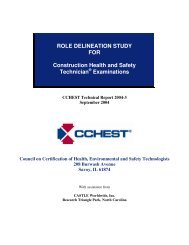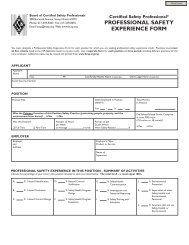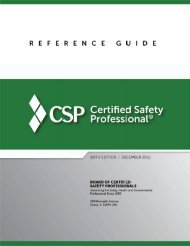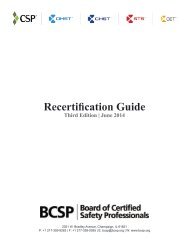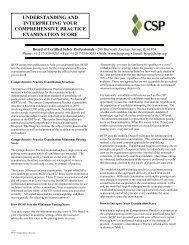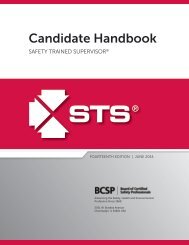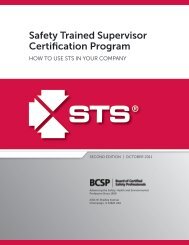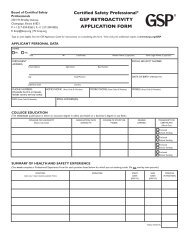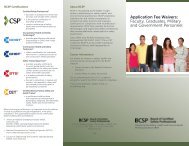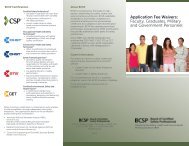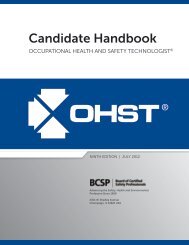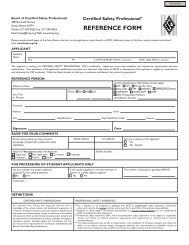CSP Application Guide - Board of Certified Safety Professionals
CSP Application Guide - Board of Certified Safety Professionals
CSP Application Guide - Board of Certified Safety Professionals
- No tags were found...
Create successful ePaper yourself
Turn your PDF publications into a flip-book with our unique Google optimized e-Paper software.
Table 3. Pr<strong>of</strong>essional <strong>Safety</strong> Job FunctionsHazard Identification: All activity related to the identification/verification<strong>of</strong> conditions, methods, or processes having the potential to cause damage orinjury to people or property. Examples <strong>of</strong> tasks: visual inspections, review <strong>of</strong>documentation, interviews or inquiries, literature searches, application <strong>of</strong> hazardanalysis methods or system safety analyses.Hazard Evaluation: The review <strong>of</strong> recognized hazards associated withconditions, methods and processes or the comparing <strong>of</strong> existing hazard levelsto standards. Examples: safety testing <strong>of</strong> equipment or processes, industrialhygiene sampling and analysis, and making computations to establish the level<strong>of</strong> hazard or risk.Hazard Control Design: Developing or proposing new methods, devices,equipment or processes that will reduce the level <strong>of</strong> hazard exposure by anacceptable amount. Examples: literature searches and consultations with experts,managers or others to identify potential hazard controls and their integrationinto existing designs or actually designing controls.Hazard Control Verification: All activity carried out to ensure that existinghazard control measures are performing as designed. Examples: conductingphysical audits and tests <strong>of</strong> methods, devices, equipment and processes anddetermining if hazard controls are in place and functioning properly.<strong>Safety</strong>/Health Program Design: The planning, preparation and proposal <strong>of</strong>written policies and programmatic descriptions explaining systematic methodsand procedures and assigning responsibilities for reducing the risk <strong>of</strong> personal injury,death or property damage. Examples: consultations and discussions with managers and<strong>of</strong>ficials about new or modified safety and health programs directly related tohazard control efforts.<strong>Safety</strong>/Health Program Evaluation: The review <strong>of</strong> existing safety and healthprograms in order to determine if program objectives are achieved. Examples:auditing <strong>of</strong> program activities, statistical analysis <strong>of</strong> program performance, andrecommending modifications to existing programs.<strong>Safety</strong>/Health Communication: The development <strong>of</strong> audio, audiovisual, printedmaterials and other communication media based on identified problems, solutionsand implementations which are directed at employees, supervision, management andexternal audiences to assist in abating accidents, injuries, or illnesses or toinform <strong>of</strong> safety and health problems and progress (not already included underthe above categories).Investigation and Statistical Reporting: The inquiry into complaints, claimedor real exposures, review <strong>of</strong> accidents, incidents, injuries and illnesses that haveoccurred along with the review <strong>of</strong> resource literature and related standards. Thedetermination <strong>of</strong> possible causal factors and remedial measures. This activity mayinclude the compilation <strong>of</strong> data and preparation <strong>of</strong> reports.<strong>Safety</strong> Training/Education: The selection and packaging <strong>of</strong> hazard-relatedinformation to assist various audiences in accepting, understanding and applyingknowledge to their respective activities, duties and responsibilities. The audiences mayinclude employees, supervisors, managers, pr<strong>of</strong>essional and technical people,and the public.Supervision <strong>of</strong> Other <strong>Safety</strong> Personnel: The direction <strong>of</strong> subordinate safetyand health personnel in order to support hazard control programs. This mayinclude routine supervision, technical guidance and evaluation <strong>of</strong> pr<strong>of</strong>essionalperformance.Environmental Protection: All activity carried out in order to characterizeand control potentially harmful agents, wastes and other effluents in order tominimize their damage to the environment and ecological systems.Neither <strong>Safety</strong>/Health Nor Environmental Functions: All activities whichdo not fall within any <strong>of</strong> the above eleven categories.11




